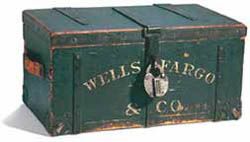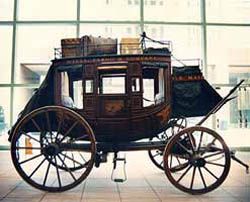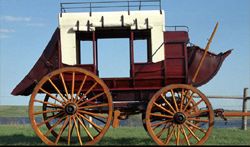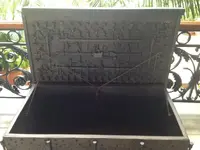BuffaloBob
Bronze Member
- Joined
- Jan 6, 2005
- Messages
- 1,367
- Reaction score
- 263
- Golden Thread
- 0
- Location
- Rocky Mountains
- Detector(s) used
- Minelab X-Terra 705 Gold Coil
deteknixXpointer Probe
Minelab Ex-Terra 70
White's Classic II
2014-2015 Colorado Gold Camp Prospector
- Primary Interest:
- Metal Detecting
- #1
Thread Owner
The Wells Fargo Treasure Box
 Gold dust, gold bars, gold coins, legal papers, checks, and drafts traveled in the famous green treasure boxes, stored under the stagecoach driver's seat. Loaded with bullion, they could weigh from 100 to 150 lbs. "About as much as one likes to shoulder to and from the stages," wrote John Q. Jackson, Wells Fargo agent, in an 1854 letter to his father. Because they carried the most valuable assets of the West, these sturdy boxes of Ponderosa pine, oak, and iron were more prized by highway bandits than anything else.
Gold dust, gold bars, gold coins, legal papers, checks, and drafts traveled in the famous green treasure boxes, stored under the stagecoach driver's seat. Loaded with bullion, they could weigh from 100 to 150 lbs. "About as much as one likes to shoulder to and from the stages," wrote John Q. Jackson, Wells Fargo agent, in an 1854 letter to his father. Because they carried the most valuable assets of the West, these sturdy boxes of Ponderosa pine, oak, and iron were more prized by highway bandits than anything else.
But the real security of the treasure boxes came from who was guarding them — the Wells Fargo shotgun messengers. Thieves who were foolhardy enough to try and steal a treasure box would find themselves staring down the barrel of a sawed-off shotgun, loaded with 00 buckshot.
The Concord Coach
 Built high and wide to handle the rough, rutted roads of a new country, the design of a classic American vehicle was perfected in Concord, New Hampshire. Carriage builder J. Stephens Abbot and master wheelwright Lewis Downing built the famed stagecoaches of Wells Fargo & Co. Concord Coaches weighed about 2,500 pounds, and cost $1,100 each, including leather and damask cloth interior.
Built high and wide to handle the rough, rutted roads of a new country, the design of a classic American vehicle was perfected in Concord, New Hampshire. Carriage builder J. Stephens Abbot and master wheelwright Lewis Downing built the famed stagecoaches of Wells Fargo & Co. Concord Coaches weighed about 2,500 pounds, and cost $1,100 each, including leather and damask cloth interior.
The curved frame of the body gave it strength, and perhaps a little extra elbow room. Perfectly formed, fitted, and balanced wheels stood up to decades of drenching mountain storms and parching desert heat. The unique feature of these coaches was the suspension. Instead of steel springs, the coach body rested on leather "thoroughbraces," made of strips of thick bullhide. This feature spared the horses from jarring and gave the stagecoach a (sometimes) gentle rocking motion, leading Mark Twain to call it, "An imposing cradle on wheels."
Mud Wagon
 While the Concord Coach was considered the 'Star of the Road,' the Passenger Wagon, also called the Celerity Coach, was the true work horse. The advantage of the passenger wagon and the origin of its nickname, Mud Wagon, was the lightness that enabled it to pass frequently over poor and soft roadways, through mud holes, or up steep mountainous slopes. These light semi-enclosed carriers are equipped with canvas or enameled leather storm curtains, and brakes for mountain travel.
While the Concord Coach was considered the 'Star of the Road,' the Passenger Wagon, also called the Celerity Coach, was the true work horse. The advantage of the passenger wagon and the origin of its nickname, Mud Wagon, was the lightness that enabled it to pass frequently over poor and soft roadways, through mud holes, or up steep mountainous slopes. These light semi-enclosed carriers are equipped with canvas or enameled leather storm curtains, and brakes for mountain travel.
The Mud Wagons are lighter and the wheels are three inches wide, as opposed to Concord's two-inch wheels. With its outside framing and square body they were less expensive to build and durable in service. These vehicles cost about 35% of what the Concord cost to build. The body of these wagons are bolted to iron rockers that, in turn, rest on leather thoroughbraces. The body measures from 6'10" to over 8' high, the track 5'2" (in the U.S.) or 4'8" (in Canada), and it weighs from 800 pounds, for the commonest nine-passenger model, to 1200 pounds for a 18 passenger. It has two to three inside seats (no roof passengers), and baggage is stored in the single rear boot or piled inside with the passengers. Up front is the driver and shotgun rider. Selection of the type of stage to use might be determined by availability, the terrain — such as mud or soft sand, and the passengers and cargo to be carried in each direction.
The Mud Wagon was often employed in hostile Indian country, where the Concords might be too valuable to risk. Indians were likely to set the coach afire if they took it. For the driver's sake, the front boot and the seats were protected by sheet metal, heavy enough to stop an arrow and perhaps a bullet.

But the real security of the treasure boxes came from who was guarding them — the Wells Fargo shotgun messengers. Thieves who were foolhardy enough to try and steal a treasure box would find themselves staring down the barrel of a sawed-off shotgun, loaded with 00 buckshot.
The Concord Coach

The curved frame of the body gave it strength, and perhaps a little extra elbow room. Perfectly formed, fitted, and balanced wheels stood up to decades of drenching mountain storms and parching desert heat. The unique feature of these coaches was the suspension. Instead of steel springs, the coach body rested on leather "thoroughbraces," made of strips of thick bullhide. This feature spared the horses from jarring and gave the stagecoach a (sometimes) gentle rocking motion, leading Mark Twain to call it, "An imposing cradle on wheels."
Mud Wagon

The Mud Wagons are lighter and the wheels are three inches wide, as opposed to Concord's two-inch wheels. With its outside framing and square body they were less expensive to build and durable in service. These vehicles cost about 35% of what the Concord cost to build. The body of these wagons are bolted to iron rockers that, in turn, rest on leather thoroughbraces. The body measures from 6'10" to over 8' high, the track 5'2" (in the U.S.) or 4'8" (in Canada), and it weighs from 800 pounds, for the commonest nine-passenger model, to 1200 pounds for a 18 passenger. It has two to three inside seats (no roof passengers), and baggage is stored in the single rear boot or piled inside with the passengers. Up front is the driver and shotgun rider. Selection of the type of stage to use might be determined by availability, the terrain — such as mud or soft sand, and the passengers and cargo to be carried in each direction.
The Mud Wagon was often employed in hostile Indian country, where the Concords might be too valuable to risk. Indians were likely to set the coach afire if they took it. For the driver's sake, the front boot and the seats were protected by sheet metal, heavy enough to stop an arrow and perhaps a bullet.




